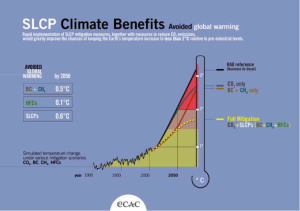Cutting Short-Lived Climate Pollutants Key for Near-Term Climate Protection
Leader level participation in climate policy set stage for progress in Lima
As UN climate discussions in Lima move toward their conclusion, there is a sense that the parties will produce a draft compilation of elements as the basis for negotiating a final agreement, largely because they have no choice if they want to conclude an agreement next December in Paris.
There is also a growing acceptance that at its best, the UN climate process will not be able to motivate sufficient ambition to solve the fast growing climate challenge and keep temperatures from rising beyond the 2°C guardrail above pre-industrial levels. The 2015 agreement will be a platform that allows parties to get started in 2020, when the agreement would go into effect. Some parties will start earlier and will include stretch goals, but many others are likely to stick with more modest goals that they can be confident of achieving.
“Accepting the limits of the future climate treaty puts the spotlight on complementary initiatives that can bring home additional mitigation, especially in the gap up to 2020,” according to Durwood Zaelke, President of the Institute for Governance & Sustainable Development, speaking at an event in Lima. “We could lose the game by 2020 without immediate mitigation to complement the future climate agreement. The need for speed is imperative, and the climate agreement is clearly not going to provide it.”
“The biggest and fastest near-term mitigation is to cut ‘short-lived climate pollutants’—black carbon, methane and tropospheric ozone, and hydrofluorocarbons, or HFCs,” Zaelke said. “Cutting these pollutants using existing technologies and existing laws and institutions can cut the rate of warming in half, and in the Arctic by two-thirds in the near-term. This will avoid up to 0.6°C of warming by 2050, compared to avoided warming of 0.1°C at mid-century through an ambitious effort to cut CO2. By end of century, cutting the short-lived climate pollutants can avoid up to 1.5°C of warming, comparable to aggressive CO2 mitigation.” Zaelke quoted from a publication he wrote with Nobel Laureate Mario Molina and Professor V. Ramanathan, at Scripps Institution of Oceanography, University of California, San Diego, “As Climate Impacts Accelerate, Speed of Mitigation Becomes Key,” See also Figure on next page.
“HFCs can be phased down next year under the Montreal Protocol, which has already phased out nearly 100 similar fluorinated gases by nearly 100% over its 27 years of operation,” Zaelke added. “This would provide the equivalent of between 100 and 200 billion tonnes of CO2 in mitigation by essentially eliminating one of the six main greenhouse gases. Further mitigation would come from the improvements in energy efficiency the air conditioners and other appliances as they shift to climate friendly substitutes for HFCs.”
President Obama’s climate détente with President Xi of China started with a series of agreements on HFCs negotiated with President Xi, beginning last June at their first meeting in Sunnylands California, where they also agreed to work together on North Korea. More recently President Obama also reached agreement with Prime Minister Modi of India to use the Montreal Protocol to phase down HFCs. At the annual Meeting of Parties last month in Paris, donor countries agreed to put $507.5 million into the Montreal Protocol’s dedicated funding mechanism, and to hold an extra meeting next April to address HFCs, along with the regular meetings in July and November 2015.
“Success phasing down HFCs under the Montreal Protocol next year in November will provide further momentum for success with the climate negotiations in Paris in December,” Zaelke said. “The fastest way to Paris goes through Montreal.”
“President Obama deserves credit for moving climate protection to the leader level, where it belongs along side other national security issues. He also deserves credit for pioneering an approach that embraces complementary mitigation opportunities, including the Montreal Protocol and the Climate and Clean Air Coalition to Reduce Short-Lived Climate Pollutants.” The Coalition was started by the U.S. and a small group of allies two years ago, and now with 100 partners, including nearly 50 countries, divided fairly evenly between developing and developed.”
Signaling the growing recognition of the importance of the short-lived climate pollutants at COP 20, more than thirteen events highlighted the importance of fast action to cut these pollutants. Zaelke spoke at several, including at Potent pollutants: Addressing Near-term Climate Change Through SLCPs, and at another at the Peruvian Supreme Court.
IGSD’s Primer on HFCs is here.
Source: Climate and Clean Air Coalition to Reduce Short-Lived Climate Pollutants (2014) TIME TO ACT, at 22.
